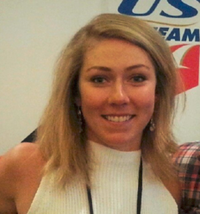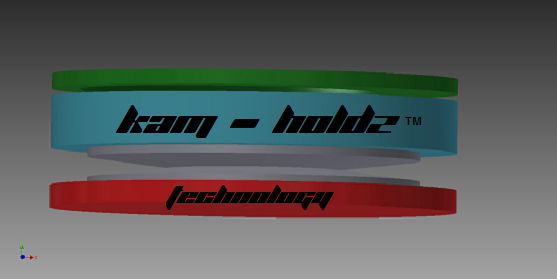MIKAELAS SECRETS:
Closing in on the womens' overall Alpine World Cup Title. |
Alpine skiing phenom Mikaela Shiffrin is closing in on the overall World Cup Womens Alpine Ski Championship, to become the worlds best woman ski racer. So what does her training regimen of juggling have to do with anything? Is it just balance and hand and eye coordination. Or is there more?
A Slalom and now Giant Slalom specialist, the turns are short and quick, and in every turn her support comes from the edge of the ski. Her skis hit the new edge of the ski inside the arc of the turn as quickly as one hand rises above the other.
|
|
HANGING WITH TED and MIKAELA
|
At the National Ski Areas Association convertion in San Francisco, I got to spend a few minutes with Mikaela Schriffrin and Ted Ligety, reigning slalom and giant slalom Olympic Alpine Gold Medalists. That was interesting, because I was aware of Michaelas emphasis on keeping the hands forward in her skiing. That is part and parcel of RIDE IN HARMONY™ as well. She said that her mother emphasized that, to keep from getting an ACL injury.
That is part of the RIDE IN HARMONY™ method for skiing for the same reason, though originally, we just noticed that people skied well, with a minimum of effort by just pointing, moving the Turn-side™ hand up and forward. This was the zen deduction of the pole swing, carried through the turn, that rolled the ski onto the new edge. There was better balance and it kept the body from twisting inward to put a strain in the leg.
Mikaela is the #1 ranked woman overall, and is favored to cement the title in Aspen at the World Cup finals this week in Aspen, Co. She turns 22 on Monday.
|
Mikaela Shiffrin
Olympic and World Cup Alpine Slalom Champion
|
 |
START an ACL AWARENESS PROGRAM
AT YOUR SKI AREA, CLUB, join the Hundreth Monkey Club
What's that? That's the point where something becomes general knowledge. It goes like this. By the time a hundred monkeys have been trained to do something, all the monkeys in the forest know it. By the time a hundred people at your ski area adopt ACL Awareness protocols, the rest will know about it and begin to discuss it among themselves. Does it guarantee you won't get hurt. Of course not. Two of the people above had knee injuries last year, but it puts knowledge and awareness on your side. You decide. It's your decision. Information presented is for your evaluation, but it hasn't evolved in a vacuum.
|
ACL Awareness Compliant™
The teaching method and practices of RIDE IN HARMONY™, are consistent with information about avoiding the most common major injuries to the knee, and we have evolved some of our own common sense strategies, to boot. Oh yeah, that's one of them. Get the right boot, and learn your boot size in "ski talk", so you know whether you are getting a boot in your size or not.
The ski season is just around the corner, so here are a couple reminders, and where to get help.
What causes an ACL injury?
- An inward twist or rotation of the outside femur, at the knee, that is excessive or sudden. Sometimes it's in a turn, a fall, or upon landing from a jump.
- What USUALLY starts the excessive internal twist? The Turn-side™ hand, the one inside the arc of the turn with which you make a pole swing, drops back and in, and the hip falls behind the ankle. While the outside foot is relatively stationary, trapped, or posted in one place, the ski and body twist against each other.
- Is this a simplified or comprehensive description? It highlights major factors that can be addressed on short notice, like when you rent a ski, but it applies in about seventy percent of the ACL ruptures, the most common major ski injury.
- Does it cover all of the circumstances affecting an ACL injury, and it's prevention. No. But the ones it does will continue to be relevant as long as you ski and ride.
- Is this a gender issue? Yes. Women have two to ten times the ACL injuries in sports that men do. But men have them too.
Let's keep the first list short:
ACL Checklist:
1. Know your foot size and boot size. The boot should be the same size, or smaller than your foot, fitting like a glove, comfortably, to steer the ski when your foot moves.
Ski Boots are sized in a system called Mondopoint, from Europe, with two numbers. Most of the sizes in Mondopoint can be understood by adding the two numbers together. So a size 8 in a regular shoe, is a marked as 26. 2+6=8 so size26 in a ski boot is equal to size 8 in a reglar shoe. Getting a larger boot than your foot size can be like installing loose steering on a car.
2. Turnside™ hand up and forward, RIH style. The First three lessons, train you to move the hands forward. That untwinds the body, and tips the ski on edge. That, and the right equipment set up, keep you in the center of a functional range of motion.
3. Two footed foot movements. Lesson 4. Tail of the Dolphin Learn to move your both feet independently, in unison, without being locked together.Learn at your own pace on slopes you are comfortable skiing and riding, then work up. Support from both feet is stronger than just one. The IOC, or International Olympic Cimmittee, also recommends two footed movements to reduce ACL injuries.
4. You want both feet to roll onto and off of edge at the same time so, extra credit if you can get your boot fitter to adjust your cuff, if a rental, or you have effective foot beds that support both feet in a neutral position. This is a prophylactic arrest of inward rotation of the femur or knee. Ask the pro in your ski shop who they recommend to adjust your stance with a footbed in your boot, often a pedorthist. Especially if your knees touch before your ankles do when you draw them together, you may not be getting the support that you need from the edge of both skis at the same time.
5. Center of a functional range of motion. Ankles under the hips. Draw them back in each turn until you feel comfortable with them there most the time, as you flex and extend. This is new. Not to RIH-WAAY, but to the beginning training protocol.
There is more but this is a start.
Contact us to discuss an ACL AWARENESS program at your ski area for employees and gue
You'll be glad you did.
cary@rideinharmony.com
Phone 970.274.0365
______________________________________________________________________________________________________________________________
Patented use of gravity

Ride In Harmony™ Founder, Cary Thompson , has been issed a patent with 19 claims by the US Patent and Trademark Office, for telemark bindings. Dave Durrance of the legendary ski family is named on the patent, as well, for his work assembling the first prorotype. The Kam-Holdz™ binding, operating like a shoulder or hip joint, features a partial release system which pivots back into place with a gravity assist, following recovery from a fall.
Welcome the security of the release of the ski in a fall, and stay with it for enhanced performance because of its ergonomic location at the center the ski or board.
When you become comfortable as an Alpine skier, you may want to experience the "Unbearable lightness of skiing", which is Telemark, and the patented "return to center force" of KAM-HOLDZ™ Technology, (with apologies to Milan Kundera).
|
 Many of our guests have been attracted by the ACL friendly component of our teaching method. |
|
VISIT OUR WEBSITE:
Think of our website as having 3 Rivers To One Ocean
|
IN THIS ISSUE
Kbbbbbbb b
Michaela Schriffrin
Mikaela Schriffrin and Ted Ligety
KAM-HOLDZ™ Technology -Patented use of Gravity
The Residence Hotel - Aspen, a Luxury Boutique Hotel
Outski Your Son At 65 - Testimonial
ACL Awareness Compliant™ - Take care of your knees
|
OUTSKI YOUR SON AT 65
|
|
Cary,
My son took me up to Telluride for my sixty fifth over the MLK long weekend. He hasn't skied for awhile, but this year he got back into it.
He hasn't seen me ski since I was Harmonized (and Shenderized) .
Being my son, he tells me to lead out on the first run. I do, put the throttle on, and wait for him at the bottom. I must admit I did some smooth skiing on that run.
So, being my son, he ups the ante, and we move on to something tougher. Same thing.
After two or three more times of this, he gets serious and we head over to Revelation Bowl. A lot of people look, but not that many people ski it. I did! Dropped right in!
Then it's time for the Plunge. He's yelling there's too many bumps, but I'm off. There was lots of loose snow and the bumps were spaced so I ran it top to bottom. No breaks.
With that he gave up and told me to show him how to do it.
We headed over to an easy blue. He had watched your video and I gave him the Shender lecture (it's short and to the point) about the importance of the uphill hand. Then I had him follow me down while I did the exaggerated hand/arm turns that Steve used with me at Snowmass,
One run. One run! The it was back to the blacks. He'd get nervous on the steep headwalls and switch hands, but he'd practice on the catwalks. We ran all the blacks at speed. As he said: 'the feet follow the hands.'
The next day it was back to the Plunge and Bushwacker, going back and forth to each run.
You can really see how the old way doesn't work on these steep runs. People get behind on each turn, because they're pulling their shoulder away from the direction of the turn as they start and then can't catch up. Two or three turns and they shoot up hill to save themselves. A lot of people standing catching their breath on the Plunge. With your technique, you bring your hand around, the shoulders square up to the fall line and the skis are right where they're supposed to be. You don't think about them! And.....at the end of the day you're not tired. Everybody else is!
Skiing steep runs, again and again, with power and control, at my age is gift.
I'm working on my son for that trip ... for some serious advanced lessons.
Mike Parr
|
|
|
|
|
It makes sence that the easiest way to learn to ski and ride, is also the safest, and consistent with safe practices.
They are not just what your body can be made to do, but what it does with the least effort, because they are natural.
But are they generally taught in ski schools? Not always. That's where RIDE IN HARMONY (TM) and its SHAPED TEACHING (TM) method come in.

en.wikipedia.org
The anterior cruciate ligament (ACL) is one of the four major ligaments of the human knee.
|
|
Ride in Harmony,llc
Supplier Member
P.O. Box 1509
Glenwood Springs, Co, USA
970.274.0365
©2000-2016 Cary Thompson
(all rights reserved)
|
|
|
|
|